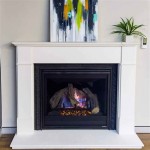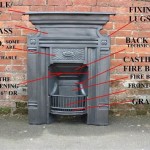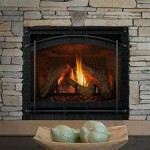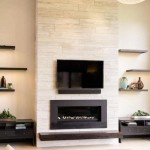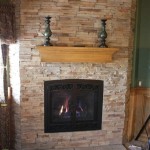In-Wall Ventless Gas Fireplaces: A Comprehensive Guide
In-wall ventless gas fireplaces offer an increasingly popular alternative to traditional wood-burning or vented gas fireplaces. Their appeal stems from their aesthetic integration within a room's design, ease of installation, and perceived convenience. However, a thorough understanding of their operational principles, safety considerations, and regulatory compliance is paramount before making a purchase.
These fireplaces are designed to operate without a chimney or external venting system. Instead, they utilize sophisticated combustion technology to burn fuel—typically natural gas or propane—more completely. This complete combustion aims to minimize the production of harmful byproducts like carbon monoxide, unburned hydrocarbons, and nitrogen oxides. The resulting heat is then radiated directly into the room, making them a potentially efficient heating source.
The “in-wall” designation signifies that the firebox is designed to be recessed into the wall cavity during installation. This creates a flush or near-flush appearance, allowing the fireplace to seamlessly integrate into the room's architectural design. This aesthetic appeal is a key factor driving the demand for in-wall ventless gas fireplaces, particularly in modern and contemporary homes.
The purchase and installation of a ventless gas fireplace represents a significant commitment. Weighing the advantages and disadvantages, understanding local regulations, and choosing a reputable installer are all crucial steps in ensuring a safe and satisfying outcome.
Installation and Placement Considerations
The installation of an in-wall ventless gas fireplace requires careful planning and adherence to manufacturer specifications and local building codes. The wall itself must be structurally sound and capable of supporting the weight of the firebox. Furthermore, the surrounding materials must be non-combustible or properly shielded to prevent fire hazards. Minimum clearances to combustible materials, as defined by the manufacturer, must be strictly observed.
Proper oxygen availability is vital for the safe operation of a ventless gas fireplace. These appliances draw combustion air from within the room, so the room must have adequate ventilation. Many jurisdictions require a minimum room size relative to the BTU input rating of the fireplace. This ensures that sufficient oxygen is available for complete combustion and prevents the build-up of carbon monoxide. Some manufacturers recommend a supplemental fresh air intake in tightly sealed homes to further enhance safety.
The placement of the fireplace within the room impacts both its aesthetic appeal and its heating efficiency. Optimally, the fireplace should be centrally located to distribute heat evenly throughout the space. Avoid placing it near drafts or in areas with high foot traffic. The height of the fireplace should also be considered to ensure comfortable viewing and prevent accidents.
Professional installation is highly recommended, if not mandated by local codes. Certified gas technicians possess the expertise to properly connect the gas line, test for leaks, and ensure that the fireplace operates safely and efficiently. Attempting a DIY installation without the necessary skills and knowledge can be dangerous and potentially violate building regulations.
Safety and Maintenance Protocols
Although designed for safe operation, ventless gas fireplaces require responsible use and regular maintenance to minimize potential risks. Carbon monoxide (CO) detectors are essential safety devices that should be installed in any room where a ventless gas fireplace is used, as well as in adjacent rooms. These detectors should be tested regularly and replaced according to the manufacturer's recommendations. It is crucial to understand that CO is odorless and colorless, making detection impossible without a dedicated device.
Regular cleaning and inspection are essential for maintaining the safe and efficient operation of the fireplace. The burner assembly should be cleaned periodically to remove dust, soot, or other debris that could impede proper combustion. The pilot light should be inspected regularly to ensure that it is burning cleanly and consistently. If any unusual odors, noises, or flame patterns are observed, the fireplace should be shut down immediately and inspected by a qualified technician.
It is crucial to only burn the fuel specified by the manufacturer – either natural gas or propane. Attempting to burn other fuels, such as wood or artificial logs, can create hazardous conditions and void the warranty of the fireplace.
Children and pets should be supervised around operating fireplaces. The glass front of the firebox can become extremely hot, posing a burn risk. Safety screens or barriers can be installed to prevent accidental contact.
Avoid placing combustible materials, such as furniture, curtains, or decorations, too close to the fireplace. The radiant heat can ignite these materials, creating a fire hazard. Adherence to the manufacturer's recommended clearances is critical.
Regulatory Compliance and Local Codes
Ventless gas fireplaces are subject to strict regulations and safety standards. These regulations are designed to ensure that the fireplaces operate safely and do not pose a health risk to occupants. The Underwriters Laboratories (UL) and the Canadian Standards Association (CSA) are the primary organizations that test and certify gas fireplaces, ensuring they meet established safety standards. Look for the UL or CSA listing mark on any ventless gas fireplace you are considering purchasing.
Many jurisdictions have specific building codes that govern the installation and use of ventless gas fireplaces. These codes may specify minimum room sizes, ventilation requirements, sensor requirements, and other safety measures. It is essential to consult with local building officials before purchasing or installing a ventless gas fireplace to ensure compliance with all applicable regulations.
Some jurisdictions prohibit the use of ventless gas fireplaces altogether due to concerns about indoor air quality. Other jurisdictions may have restrictions on the maximum BTU input rating of ventless fireplaces or the types of rooms in which they can be installed. Failure to comply with local codes can result in fines, penalties, and potentially dangerous conditions.
When purchasing a ventless gas fireplace, be sure to obtain all necessary permits and approvals from local building officials. This will ensure that the installation is inspected and certified to meet all applicable safety standards.
Understanding and complying with the regulatory landscape surrounding ventless gas fireplaces is paramount. Local regulations are put in place to prioritize your safety and those sharing your dwelling.

Vent Free Archives SÓlas Contemporary Fireplaces

Duluth Forge Dual Fuel Ventless Gas Fireplace 26 000 Btu T Stat Control Antique White Finish Com

Modern Ventless Gas Fireplace With White Soft Carpet Casa Moderna Hogar Chimeneas
:max_bytes(150000):strip_icc()/ventless-gas-fireplaces-4160746-hero-f9d4bdcd9bd446eb84406de306f790ba.jpg?strip=all)
How To Pick Out A Ventless Gas Fireplace

Fireplace Insert Short Wall Google Search Natural Gas Contemporary

Boulevard Sl Bedroom Approved Vent Free Fireplace Fine S Gas

Plazmafire Vf24 Whvf24 Ambassador Fireplaces

Ventless Gas Fireplace Propane

Ventless Gas Fireplace Vent Free Modern

Duluth Forge Dual Fuel Ventless Gas Fireplace 26 000 Btu Remote Control Antique White Finish 170105 The Home Depot

